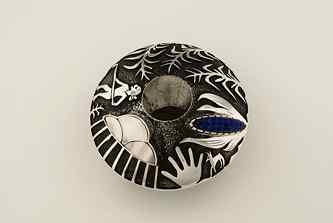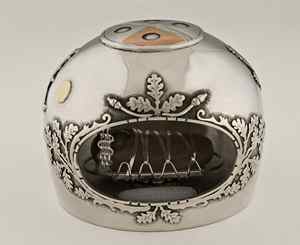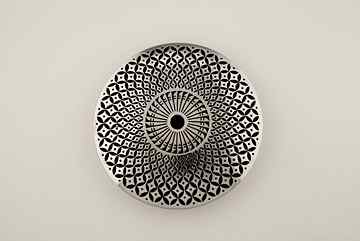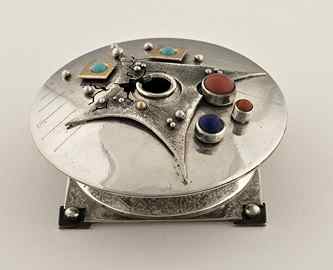Editor's note: The Heard Museum provided source
material to Resource Library for the following article or essay.
If you have questions or comments regarding the source material, please
contact the Heard Museum directly through either this phone number or web
address:
Old Traditions in New Pots:
Silver Seed Pots from the Norman L. Sandfield Collection
on display through 2008
Norman L. Sandfield
recently gifted the Heard Museum his collection of more than 240 miniature
silver seed pots. This superlative collection is on exhibit  in the Sandra Day O'Connor Gallery, at the Heard Museum.
The collection, which Sandfield collected over a period of 28 years, ranges
from traditional designs recreated in silver to a truly interstellar outlook
with the Star Wars series created by L. Eugene Nelson, Navajo.
Sandfield also commissioned works from jewelers who normally do not create
containers, and the results are stunning. (left: Harvest Time)
in the Sandra Day O'Connor Gallery, at the Heard Museum.
The collection, which Sandfield collected over a period of 28 years, ranges
from traditional designs recreated in silver to a truly interstellar outlook
with the Star Wars series created by L. Eugene Nelson, Navajo.
Sandfield also commissioned works from jewelers who normally do not create
containers, and the results are stunning. (left: Harvest Time)
Seed pots were originally pottery items and were created
for a far different purpose than beauty: American Indian tribal communities
relied on the small pots with tiny holes to safely store seeds for the following
growing season. Naturally, as Indians do not recognize a discrete word for
"art," these pots, which seldom exceeded about 2 inches in diameter,
were festooned with carvings and designs.
Later, artists began casting these everyday pots from silver
instead of throwing them on a pottery wheel. However, the artistry did not
suffer; indeed, it's grown over the years as Native artists stretch their
creativity to form ever more beautiful -- even whimsical -- pots from silver,
gold and stones.
Collector's Statement
A long history of beautiful ceramic vessels inspires the
American Indian artists who make silver seed pots. These miniature works
of art incorporate design  elements
from traditional Navajo and Hopi pots, textiles, and baskets, as well as
other sources. The artists who fashion them bring together the best of two
worlds, taking designs that were previously in the domain of American Indian
potters, weavers, and basket makers, and adding to them their modern talent
for working with silver, gold, and stones. They bring their experience as
designers and makers of fine jewelry to these jewelry-like miniature works
of art. While not functional, the pots do contain the spirit of traditional
vessels made by the artists' ancestors. The contemporary silver seed pots
continue the ancient heritage of utilitarian storage pots. The miniature
silver pots incorporate elegant silhouettes, precise exterior designs, and
the occasional surprise of interior decoration or embellishment. (right:
Havasupai Seed Corn)
elements
from traditional Navajo and Hopi pots, textiles, and baskets, as well as
other sources. The artists who fashion them bring together the best of two
worlds, taking designs that were previously in the domain of American Indian
potters, weavers, and basket makers, and adding to them their modern talent
for working with silver, gold, and stones. They bring their experience as
designers and makers of fine jewelry to these jewelry-like miniature works
of art. While not functional, the pots do contain the spirit of traditional
vessels made by the artists' ancestors. The contemporary silver seed pots
continue the ancient heritage of utilitarian storage pots. The miniature
silver pots incorporate elegant silhouettes, precise exterior designs, and
the occasional surprise of interior decoration or embellishment. (right:
Havasupai Seed Corn)
In so many ways this collection is about the artists --
their cultures, their talents, and their heritage. My hope is that this
exhibition of silver seed pots inspires future artists to create pots with
their own stamp of individuality and creativity. May it also inspire future
collectors to find some special niche that they can love, collect, document,
and eventually share with the world.
--Norman L. Sandfield
Note: This exhibition does not include all of the silver seed pots
in the Sandfield Collection or in the book about the collection. Some of
the pots are now on long-term display at Heard Museum North Scottsdale,
at Heard West in Surprise, and a few others are in the museum's collection,
available for study and loan purposes.
Curator's Statement
Cultures throughout the world have held vessels in great
esteem. Containers are known to hold visible items of value, but they also
hold thoughts, prayers,  and other
forms of sustenance. On the spiritual level they relate to the human need
to protect what is sacred, and as articles of everyday utility, they play
an intimate and very personal role in our lives. (left: Silver
Seed Pot)
and other
forms of sustenance. On the spiritual level they relate to the human need
to protect what is sacred, and as articles of everyday utility, they play
an intimate and very personal role in our lives. (left: Silver
Seed Pot)
The pots in the Sandfield Collection are inheritors of
the ancestral traditions of both sacred and utilitarian vessels. In a sense
the historic seed pot was both -- it was a useful object that held the gestational
power of the next season's sustenance, and thus the life of the people.
Corn, squash, and other seeds were stored in these clay pots with their
characteristically small openings intended to keep their contents dry. At
planting time the pots were shaken or broken to release the seeds.
The Sandfield Collection includes more than 240 miniature
silver seed pots by some 70 artists, and the miniatures are in some way
an essay on the life of the artists -- as the pots reveal their makers'
insights and interests, their environments and experiences, as well as their
knowledge of the ancient art of metalsmithing. The recent history
of silver seed pots dates to approximately 1975, with the majority made
since the 1980s. The silversmiths credited with making the first miniature
silver pots are Norbert Peshlakai, Navajo, and White Buffalo, a.k.a.
Mike Perez, Comanche/Mexican. As the artists drew upon the classic
forms and designs, their work evolved through the art of silversmithing.
As Sandfield describes it, "These artists are jewelers first, and the
pots are an extension of that field."
The Sandfield Collection spans the "life" of
an artform that continues to grow and delight with the impressive vision
and talent of contemporary silversmiths.
--Tricia Loscher, Exhibit Curator

(above: L. Eugene Nelson, Navajo, Star Wars)
Editor's note: RL readers may also enjoy:
Read more articles and essays concerning this institutional
source by visiting the sub-index page for the Heard
Museum in Resource Library.
Search Resource
Library for thousands of articles and essays on American art.
Copyright 2008 Traditional Fine Arts Organization, Inc., an Arizona nonprofit corporation. All rights
reserved.
 in the Sandra Day O'Connor Gallery, at the Heard Museum.
The collection, which Sandfield collected over a period of 28 years, ranges
from traditional designs recreated in silver to a truly interstellar outlook
with the Star Wars series created by L. Eugene Nelson, Navajo.
Sandfield also commissioned works from jewelers who normally do not create
containers, and the results are stunning. (left: Harvest Time)
in the Sandra Day O'Connor Gallery, at the Heard Museum.
The collection, which Sandfield collected over a period of 28 years, ranges
from traditional designs recreated in silver to a truly interstellar outlook
with the Star Wars series created by L. Eugene Nelson, Navajo.
Sandfield also commissioned works from jewelers who normally do not create
containers, and the results are stunning. (left: Harvest Time) elements
from traditional Navajo and Hopi pots, textiles, and baskets, as well as
other sources. The artists who fashion them bring together the best of two
worlds, taking designs that were previously in the domain of American Indian
potters, weavers, and basket makers, and adding to them their modern talent
for working with silver, gold, and stones. They bring their experience as
designers and makers of fine jewelry to these jewelry-like miniature works
of art. While not functional, the pots do contain the spirit of traditional
vessels made by the artists' ancestors. The contemporary silver seed pots
continue the ancient heritage of utilitarian storage pots. The miniature
silver pots incorporate elegant silhouettes, precise exterior designs, and
the occasional surprise of interior decoration or embellishment. (right:
Havasupai Seed Corn)
elements
from traditional Navajo and Hopi pots, textiles, and baskets, as well as
other sources. The artists who fashion them bring together the best of two
worlds, taking designs that were previously in the domain of American Indian
potters, weavers, and basket makers, and adding to them their modern talent
for working with silver, gold, and stones. They bring their experience as
designers and makers of fine jewelry to these jewelry-like miniature works
of art. While not functional, the pots do contain the spirit of traditional
vessels made by the artists' ancestors. The contemporary silver seed pots
continue the ancient heritage of utilitarian storage pots. The miniature
silver pots incorporate elegant silhouettes, precise exterior designs, and
the occasional surprise of interior decoration or embellishment. (right:
Havasupai Seed Corn) and other
forms of sustenance. On the spiritual level they relate to the human need
to protect what is sacred, and as articles of everyday utility, they play
an intimate and very personal role in our lives. (left: Silver
Seed Pot)
and other
forms of sustenance. On the spiritual level they relate to the human need
to protect what is sacred, and as articles of everyday utility, they play
an intimate and very personal role in our lives. (left: Silver
Seed Pot)